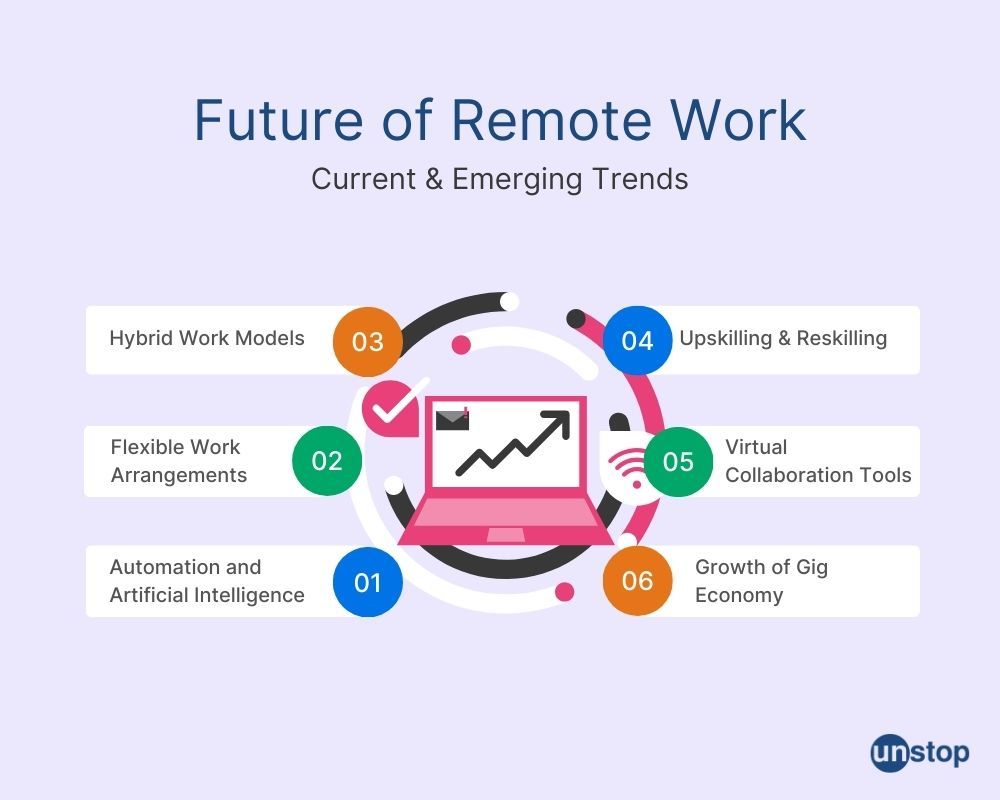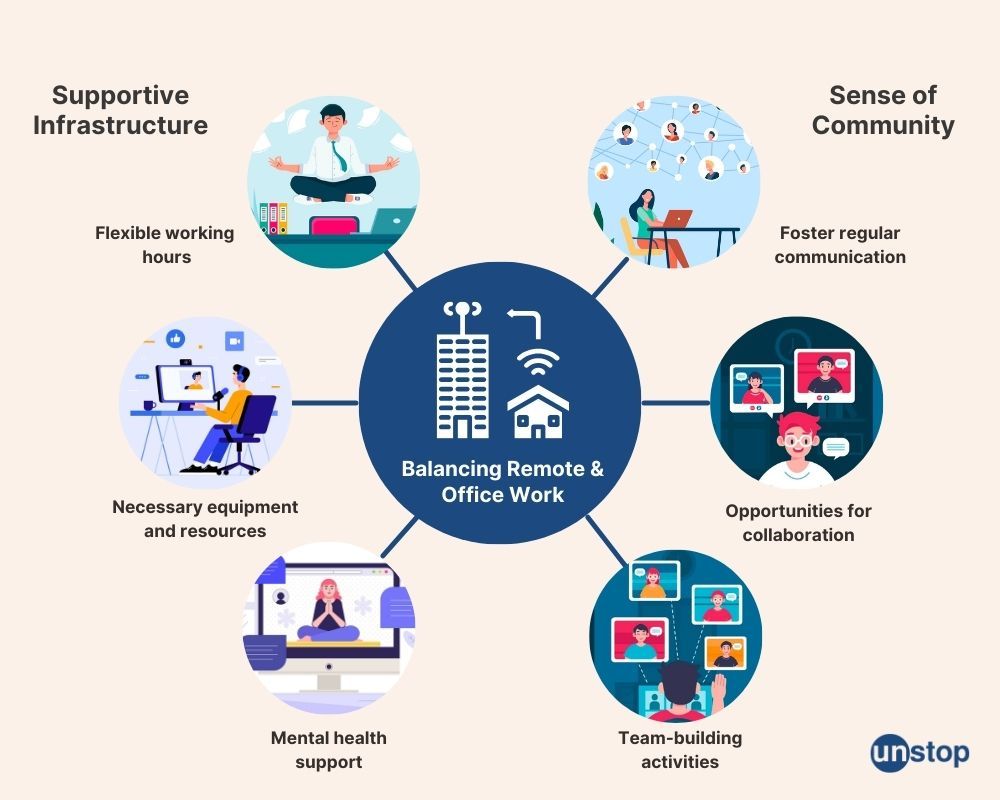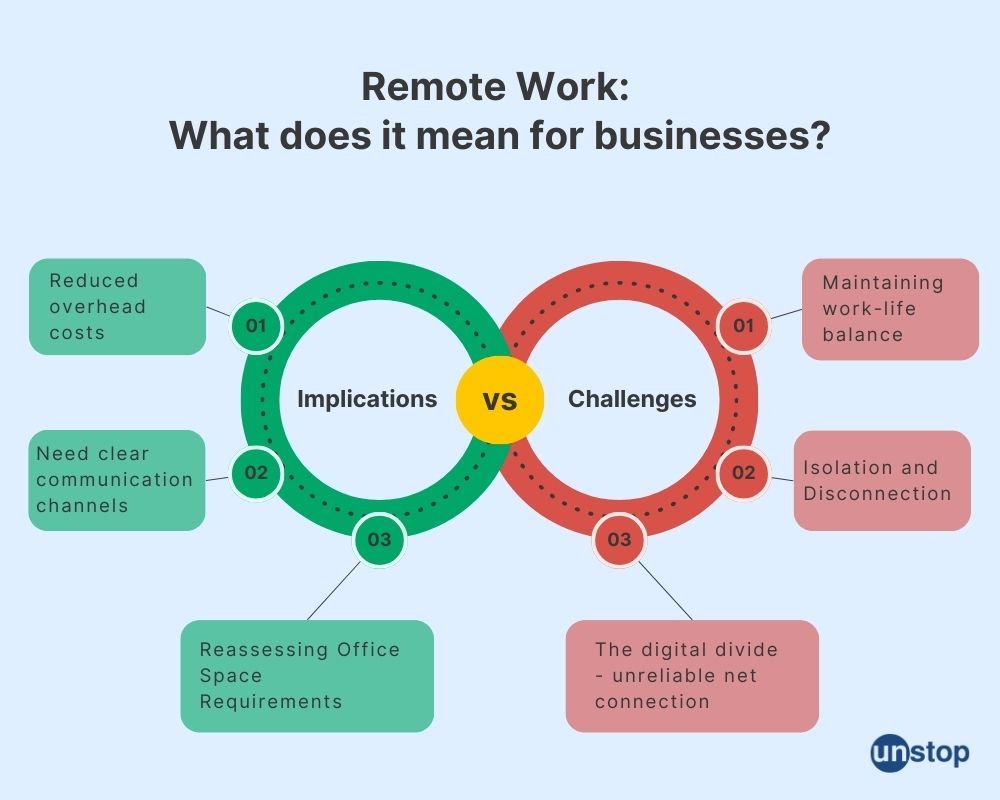- Future of Remote Work: Current & Emerging Trends
- Balancing Remote and Office Work: Making The Hybrid Model Work
- Implications of Remote Work on Businesses
- Addressing Challenges in Remote Work
- Frequently Asked Questions (FAQs)
Future of Remote Work Is Hybrid: A Look At The Latest Trends

Remote work has gained immense popularity worldwide, and recent technological advancements have made it more accessible than ever before. The COVID-19 pandemic further accelerated the adoption of remote work, forcing companies to experiment with this new way of operating. As a result, many organizations have come to realize the potential benefits of remote work, such as increased productivity and cost savings.
However, in this post-pandemic era, employees and employers, alike, are at a crossroads between remote work and coming to the office. Can a long commute make up for the joy of meeting your favourite co-worker? Can the excessive cost of office space make up for the benefits of cross-team collaboration? What really is the future of remote work?
Let's find answers to all these questions and more and take a look at the trends that will determine the future of remote work:
Future of Remote Work: Current & Emerging Trends

Here are the key trends that will dominate the future of remote work:
Hybrid Work Models Dominating the Future
The future of remote work is expected to be dominated by hybrid work models. This means that employees will have the flexibility to work both remotely and from the office. Companies are recognizing the benefits of this approach as it allows for a balance between productivity and collaboration.
As per a recent report by Economic Times, Stanford Professor Nick Bloom (World’s Leading WFH Researcher) stated, “typical employee wants a moderate hybrid plan. Managers seeing this should focus on making hybrid successful rather than battling for a full office return…”.
Pros:
-
Increased work-life balance for employees.
-
Cost savings for both employers and employees (commuting expenses, office space).
-
Access to a larger talent pool beyond geographical limitations.
Cons:
-
Challenges in maintaining effective communication and collaboration among remote and in-person teams.
-
Potential blurring of boundaries between work and personal life.
Prioritizing Flexible Work Arrangements
To attract top talent, companies will prioritize flexible work arrangements. They understand that offering remote work options can be a major draw for employees who value work-life balance and autonomy. By providing flexibility, companies can tap into a wider pool of talent and retain their valuable workforce.
Evolving Virtual Collaboration Tools
Virtual collaboration tools will continue to evolve and improve in 2024 and beyond. With advancements in technology, these tools will become even more seamless and efficient, enabling teams to collaborate effectively regardless of their physical location. From video conferencing platforms to project management software, these tools will play a crucial role in facilitating communication and teamwork.
-
Pros:
-
Facilitate effective communication and teamwork regardless of physical location
-
Enable seamless and efficient collaboration with advancements in technology
-
-
Cons:
-
May require a learning curve for users unfamiliar with the tools
-
Dependence on a stable internet connection for optimal performance
-
Automation and Artificial Intelligence Reshaping Job Roles
Automation and artificial intelligence (AI) are revolutionizing the labor market, leading to significant changes in job roles. As technology advances, certain tasks that were previously performed by humans are now being automated. This trend is expected to continue in the future, impacting various industries and sectors.
As per Unstop CEO Ankit Aggarwal, upskilling with AI is the need of the hour.
“As AI becomes more integrated into work processes, the demand for talent who can thrive in this new context will surge. Simultaneously, organizations must focus on elevating skill levels internally to leverage the full potential of Generative AI.” - Ankit Aggarwal
Pros:
-
Increased efficiency and productivity.
-
Reduction in repetitive tasks, allowing workers to focus on more complex and creative work.
-
Potential for new job opportunities in emerging fields related to AI and automation.
Cons:
-
Displacement of workers whose jobs can be easily automated.
-
Need for upskilling or reskilling to adapt to changing job requirements.
Gig Economy Platforms Growing in Popularity
The gig economy has gained momentum in recent years, with platforms like Uber, Airbnb, and Upwork providing flexible work opportunities. This trend is expected to continue as more workers seek autonomy and flexibility in their careers. In fact, in India, the gig workforce is expected to expand to nearly 23.5 million by 2029–30.
Pros:
-
Flexibility for workers to choose when and where they work.
-
Access to a broader range of job opportunities.
-
Ability for individuals to monetize their skills outside of traditional employment models.
Cons:
-
Lack of benefits typically associated with traditional employment (healthcare, retirement plans).
-
Uncertainty regarding income stability due to fluctuating demand for gig services.
Upskilling and Reskilling as Essential Career Advancement Strategies
With the rapid evolution of technology, upskilling and reskilling have become crucial for individuals looking to advance their careers. Continuous learning is necessary to stay relevant in a rapidly changing job market.
Pros:
-
Enhanced employability through acquiring new skills.
-
Increased adaptability to evolving technologies.
-
Opportunities for career growth within existing organizations or transitioning into new industries.
Cons:
-
Time commitment is required for ongoing learning.
-
Financial investment is needed for training programs or courses.
Looking to upskill and advance your career? Find a volley of six enviable offers with Unstop Pro, including courses, interview prep tools, and more. Explore here.
As we move towards the future of remote work, it's essential for companies to adapt to these trends. As technology continues to advance, we can expect even more innovative solutions that cater to the needs of remote workers.

Balancing Remote and Office Work: Making The Hybrid Model Work

The future of remote work looks promising, especially for industries like software development that are well-suited to telecommuting. However, finding the right balance between remote and office work is crucial.
In a quarterly report titled 'Reimagining the post pandemic workforce', management consulting firm McKinsey reported, “Avoiding the pitfalls of remote working requires thinking carefully about leadership and management in a hybrid virtual world. Interactions between leaders and teams provide an essential locus for creating the social cohesion and the unified hybrid virtual culture that organizations need in the next normal.
Here’s how organizations can achieve that balance:
Supportive Infrastructure for Remote Employees' Well-being
Companies need to provide a supportive infrastructure to ensure the well-being of their remote employees. This includes:
-
Offering flexible working hours: Allowing employees to set their own schedules can help them achieve a better work-life balance.
-
Providing necessary equipment and resources: Companies should ensure that remote workers have access to the tools and technologies they need to perform their tasks efficiently.
-
Offering mental health support: Working remotely can sometimes lead to feelings of isolation or burnout. Companies should provide resources such as counseling services or wellness programs to support their employees' mental well-being.
Maintaining a Sense of Community among Remote Workers
One challenge of remote work is maintaining a sense of community among team members who may be geographically dispersed. To address this, companies can:
-
Foster regular communication: Encouraging frequent virtual meetings, video conferences, or chat platforms helps keep team members connected and engaged.
-
Organize team-building activities: Virtual social events like online games or virtual happy hours can help foster camaraderie among remote workers.
-
Create opportunities for collaboration: Implementing collaborative tools and platforms allows remote employees to work together seamlessly on projects.
By striking a balance between telecommuting and office work, companies can maximize the benefits of both worlds. This hybrid work model promotes job satisfaction, improves productivity, and enhances employee retention.
Implications of Remote Work on Businesses

Reduced Overhead Costs
Remote work has the potential to significantly reduce overhead costs for businesses. By allowing employees to work from home or other remote locations, companies can save money on expenses such as office space, utilities, and office supplies. This can be especially beneficial for small businesses or startups with limited budgets. With remote work, businesses can allocate their resources more efficiently, investing in areas that directly contribute to growth and success.
Clear Communication Channels
Employers need to establish clear communication channels when managing remote teams. Effective communication is crucial for maintaining productivity and ensuring that everyone is on the same page. Companies should utilize various tools and technologies such as video conferencing software, project management platforms, and instant messaging apps to facilitate seamless communication among team members. Regular check-ins, team meetings, and transparent reporting systems are also essential for keeping everyone connected and informed.
Reassessing Office Space Requirements
As remote work becomes more prevalent, companies may need to reassess their office space requirements. With a significant portion of the workforce working remotely either full-time or part-time, businesses might find that they no longer require large office spaces or cubicles for every employee. Instead, they could opt for smaller shared workspaces or flexible arrangements where employees can come into the office on certain days or as needed.
Business Insider India reported that during the second quarter of 2024, office leasing across seven major Indian cities declined by 6% compared to the same period last year - led by Mumbai which saw leasing slip by 25%.
Addressing Challenges in Remote Work
Working from home or working remotely offers flexibility and convenience, but it also comes with its fair share of challenges. Let's take a closer look at some of the hurdles that individuals and society as a whole may face when embracing remote work.
Maintaining work-life balance
One challenge that many remote workers encounter is maintaining a healthy work-life balance. Without the physical separation between home and office, it can be difficult to establish boundaries and switch off from work. This can lead to longer working hours, burnout, and a lack of time for personal activities or family.
The digital divide
The digital divide presents another obstacle in the future of remote work. Not everyone has access to reliable internet connections or the necessary technology resources to effectively engage in remote work. This inequality hampers opportunities for individuals who are already marginalized or living in rural areas.
Feelings of isolation and disconnection
While remote work provides flexibility, it can also lead to feelings of isolation or disconnection from colleagues and the wider community. Without face-to-face interactions, employees may miss out on social connections, impromptu brainstorming sessions, or casual conversations that foster creativity and collaboration.
By acknowledging these challenges and taking proactive steps towards overcoming them, organizations can ensure that remote work thrives securely amidst evolving demands.
In conclusion, the future of remote work holds tremendous potential for both individuals and businesses. By embracing this shift and leveraging technological advancements, organizations can unlock new opportunities while employees enjoy greater flexibility in their professional lives. It is essential for employers to proactively address challenges associated with remote work and continuously adapt their strategies to ensure long-term success.
Frequently Asked Questions (FAQs)
1. What are some key advantages of remote work?
Remote work offers several advantages such as increased flexibility in working hours, reduced commuting time and expenses, improved work-life balance, access to a global talent pool, and a higher level of job satisfaction among employees.
2. How can businesses optimize productivity in remote work environments?
To optimize productivity in remote work environments, businesses can encourage clear communication channels, establish realistic goals and deadlines, provide necessary resources and tools for efficient workflow management, promote regular check-ins with team members, and foster a positive virtual working culture.
3. What challenges do organizations face when implementing remote work?
Organizations may face challenges such as maintaining effective communication across distributed teams, ensuring data security in remote settings, managing employee performance remotely, addressing feelings of isolation or disengagement among employees, and striking a balance between flexibility and accountability.
4. How can individuals adapt to the future of remote work?
Individuals can adapt to the future of remote work by setting up a dedicated workspace, establishing a routine that separates work and personal life, leveraging technology for effective communication and collaboration, continuously upskilling themselves to stay relevant in a digital world, and actively seeking opportunities for networking and professional growth.
5. How can employers foster employee engagement in remote work settings?
Employers can foster employee engagement in remote work settings by organizing virtual team-building activities, providing regular feedback and recognition, offering opportunities for skill development, promoting open communication channels, and encouraging social interactions among team members through online platforms.
Suggested Reads:
I’m a reader first and a writer second, constantly diving into the world of content. If I’m not writing or reading, I like watching movies and dreaming of a life by the beach.
Login to continue reading
And access exclusive content, personalized recommendations, and career-boosting opportunities.
Subscribe
to our newsletter
Blogs you need to hog!

Organize Hackathons: The Ultimate Playbook With Past Case Studies

What is Campus Recruitment? How To Tap The Untapped Talent?

Lateral Hiring: A Complete Guide To The Process, Its Benefits, Challenges & Best Practices













Comments
Add comment